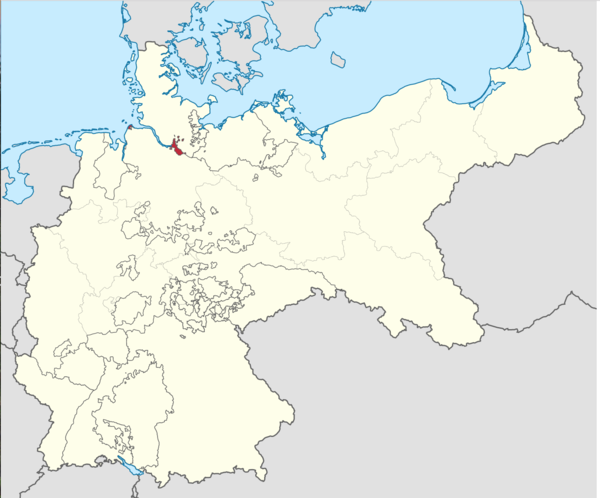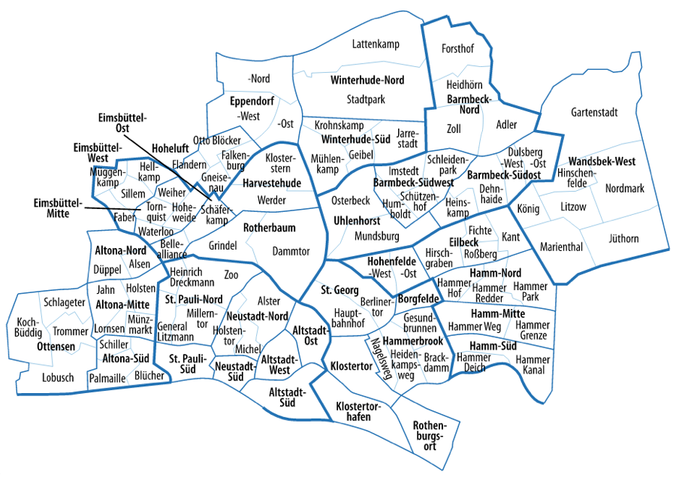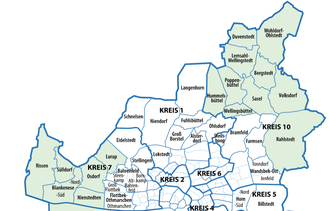Hamburg, German Empire Genealogy
Guide to Hamburg, German Empire ancestry, family history, and genealogy before 1945: birth records, marriage records, death records, both church and civil registration, compiled family history, and finding aids.
| Hamburg, German Empire Wiki Topics | |||||||
| Beginning Research | |||||||
| Major Record Types | |||||||
| Reading the Records | |||||||
| Additional Hamburg Record Types | |||||||
| Hamburg Background | |||||||
| Ethnic Groups | |||||||
| Local Research Resources | |||||||
| Germany Record Types | |||||||
| Germany Background | |||||||
| |||||||
Historical Background[edit | edit source]
- Hamburg, (officially the Free and Hanseatic City of Hamburg), was a fully sovereign city state before the 1871 unification of Germany.
- Hamburg was briefly annexed by Napoleon I to the First French Empire (1804–1814/1815). Russian forces finally freed the city in 1814. Hamburg re-assumed its pre-1811 status as a city-state in 1814.
- The Vienna Congress of 1815 confirmed Hamburg's independence and it became one of 39 sovereign states of the German Confederation (1815–1866).
- Hamburg became a member of the North German Confederation (1866–1871) and of the German Empire (1871–1918), and maintained its self-ruling status during the Weimar Republic (1919–1933).
- Hamburg was a "Gau" (a region within a country, often a former or actual province) from 1934 until 1945.
- Hamburg surrendered to British Forces on 3 May 1945. After the Second World War, Hamburg formed part of the British Zone of Occupation; it became a state of the then Federal Republic of Germany in 1949. (Wikipedia)
Getting Started[edit | edit source]
Getting Started with Germany ResearchLinks to articles on getting started with German research: |
Germany Research ToolsLinks to tools and websites that assist in German research: |
Historical Geography[edit | edit source]
|
|
| ||||
|
|
|
|
|
|
|
Hamburg, officially the Free and Hanseatic City of Hamburg |
1937-38: Exchanges of several small areas with Schleswig-Holstein (List and Map) |
|
Finding Birth, Marriage, and Death Records for Hamburg[edit | edit source]
Most of the information you need to identify you ancestors and their families will be found in two major record groups: civil registration and church records. To locate these records, follow the instructions in these Wiki articles.
1. Find the name of your ancestor's town in family history records.[edit | edit source]
Records were kept on the local level. You must know the town where your ancestor lived. If your ancestor was a United States Immigrant, use the information in the Wiki article Germany Finding Town of Origin to find evidence of the name of the town where your ancestors lived in Germany.
Also, see:
- Hamburg Passenger Lists, 1850-1934 - at Ancestry.com, ($) index and images
- Hamburg Passenger Lists, Handwritten Indexes, 1855-1934 - at Ancestry.com, ($) images
- Hamburg, Germany Emigrants - at Findmypast, ($) index
- Auswandererlisten, 1850-1934 (Hamburg passenger lists) - at FamilySearch, images
2. Use gazetteers and/or parish register inventories to learn more important details.[edit | edit source]
Your ancestor's town might have been too small to have its own parish church or civil registration office. Find the location of the Catholic or Lutheran (Evangelical) parish that served your ancestor's locality. Find the name of the civil registration office (Standesamt) that serves your ancestor's locality. Use the Wiki article Finding Aids For German Records for step-by-step instructions.
Germany was first unified as a nation in 1871. An important gazetteer, Meyers Orts- und Verkehrs-lexikon des deutschen Reichs, "Meyer's Gazetter" for short, details the place names of villages, towns, counties (kreise), and higher jurisdictions used at that time. In the Research Wiki, FamilySearch Catalog, and FamilySearch Historical Records, the records of Germany are organized using those place names.
You can also consult Hamburg Parish Record Inventories to learn the Lutheran or Catholic parish that would have kept records for your town.
At the end of both World Wars, the boundaries of the states were changed dramatically, as areas of Germany were distributed among the Allied nations. Eventually, after re-unification in 1990, the states of Germany settled into what they are today. It is also necessary to understand Germany by this system, as it affects the locations of civil registration offices, archives, and mailing addresses used in correspondence searches.
3. For birth, marriage, and death records from 1799-1814, then beginning again in October 1874, use civil registration.[edit | edit source]
Follow the instructions in Hamburg, German Empire Civil Registration.
4. For baptism, marriage, and death records, use church records or parish registers.[edit | edit source]
Follow the instructions in Hamburg, German Empire Church Records.
More Research Strategies and Tools[edit | edit source]
- Germany Online Classes and Tutorials
- German Paleography Seminar - Lessons on German Handwriting
- Old German Script Transcriber (alte deutsche Handschriften): See your family names in the script of the era. Type your name or other word into the font generator tool. Click on the 8 different fonts. Save the image to your computer and use it as you work with old Germanic records.
- Finding Aids for German Records
- Research Tips and Strategies
- German Research, BYU Independent Study, no cost.
- These printable handouts can be used for ready reference when reading German Handwriting.
- Letters:
- Vocabulary found on Specific Records:
- Dates, Numbers, Abbreviations:
- Miscellaneous Vocabulary:
- Fraktur:
- Fraktur Font -- Many forms and books are printed in this font.
- German Given Names:
- List of Names in Old German Script -- A comprehensive list of German given names, written in old script, with possible variations.





